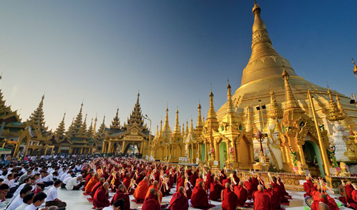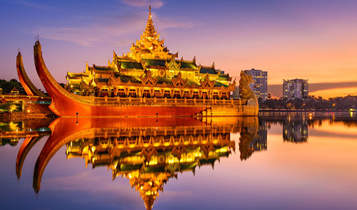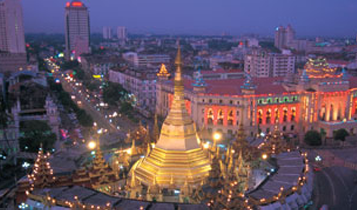


Yangon is the capital of the Yangon Region of Myanmar, also known as Burma. Yangon served as the capital of Myanmar until 2006. With over 7 million people, Yangon is Myanmar's largest city and it’s the most important commercial centre. Yangon boasts the largest number of colonial-era buildings in Southeast Asia, and has a unique colonial-era urban core that is remarkably intact. The colonial-era commercial core is centred around the Sule Pagoda, which is reputed to be over 2,000 years old. The city is also home to the gilded Shwedagon Pagoda – Myanmar's most sacred Buddhist pagoda.
The largest and best maintained parks in Yangon are located around Shwedagon Pagoda. To the south-east of the gilded stupa is the most popular recreational area in the city – Kandawgyi Lake. The 150-acre (61-ha) lake is surrounded by the 110-acre (45-ha) Kandawgyi Nature Park, and the 69.25-acre (28-ha) Yangon Zoological Gardens, which consists of a zoo, an aquarium and an amusement park.West of the pagoda towards the former Hluttaw (Parliament) complex is the 130-acre (53-ha) People's Square and Park. A few miles north of the pagoda lies the 37-acre (15-ha) Inya Lake Park –a well-known place of romance in Burmese popular culture.
Hlawga National Park and Allied War Memorial at the outskirts of the city are popular day-trip destinations with the well-to-do and tourists.
The Shwedagon Pagoda (officially named Shwedagon Zedi) and also known as the Great Dagon Pagoda and the Golden Pagoda, is a gilded stupa located in Yangon, Myanmar. The 99-metre-tall (325 ft) pagoda is situated on Singuttara Hill, to the west of Kandawgyi Lake, and dominates the Yangon skyline.
Shwedagon Pagoda is the most sacred Buddhist pagoda in Myanmar, as it is believed to contain relics of the four previous Buddhas of the present kalpa. These relics include the staff of Kakusandha, the water filter of Koṇāgamana, a piece of the robe of Kassapa, and eight strands of hair from the head of Gautama.
The Sule is a Burmese stupa located in the heart of downtown Yangon, occupying the centre of the city and an important space in contemporary Burmese politics, ideology and geography.
Yangon is Burma's main domestic and international hub for air, rail, and ground transportation. Yangon International Airport, located 12 miles (19 km) from the centre, is the country's main gateway for domestic and international air travel. The airport has three terminals, known as T1, T2 and T3 which is also known as Domestic. It has direct flights to regional cities in Asia, mainly: Doha, Dubai, Dhaka, Kolkata, Hanoi, Ho Chi Minh City, Hong Kong, Tokyo, Beijing,Phnom Penh, Seoul, Guangzhou, Taipei, Bangkok, Kuala Lumpur, Kunming and Singapore. Although domestic airlines offer service to about twenty domestic locations, most flights are to tourist destinations such as Bagan, Mandalay, Heho and Ngapali, and to the capital Naypyidaw.
Yangon Central Railway Station is the main terminus of Myanmar Railways' 5,403-kilometre (3,357 mi) rail network[40] whose reach covers Upper Myanmar (Naypyidaw, Mandalay, Shwebo), upcountry (Myitkyina), Shan hills (Taunggyi, Lashio) and the Taninthayi coast (Mawlamyine, Dawei).